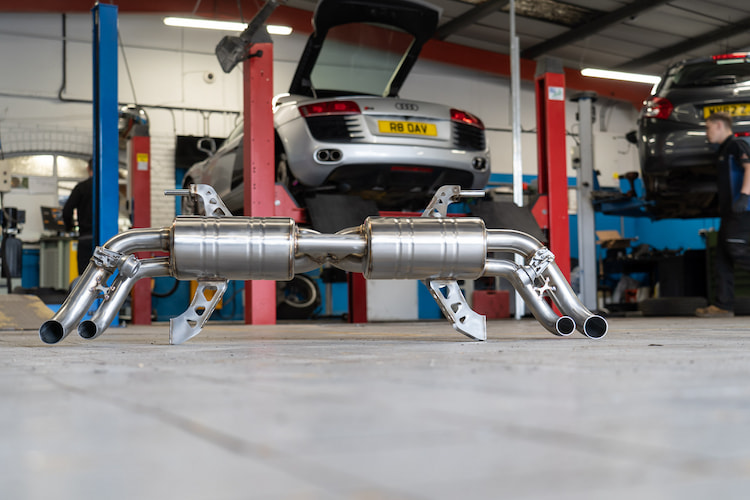Automobile manufacturers often face a challenging balancing act when designing stock exhaust systems for their vehicles. On one hand, they must adhere to strict regulations, meet cost-effective production targets, and prioritize mass appeal. On the other hand, performance enthusiasts and discerning drivers often seek more from their vehicles than what the stock exhaust system provides. This is where aftermarket exhaust systems come into play, offering a world of customization, improved performance, and a unique auditory experience. In this article, we’ll explore the reasons why stock exhaust systems often fall short, how aftermarket exhausts differ, and the crucial considerations for selecting the right aftermarket exhaust system for your vehicle.
The Cost-Cutting Conundrum in Stock Exhaust Production
Stock exhaust systems, also known as OEM (Original Equipment Manufacturer) exhaust systems, are meticulously designed to meet several criteria: cost-effectiveness, noise regulations, emission standards, and mass production efficiency. Manufacturers aim to minimize costs in various ways, including using inexpensive materials, such as mild steel, and designing exhaust systems with narrow diameters and restrictive bends. These cost-cutting measures can result in several drawbacks for drivers who desire more from their vehicle’s performance and sound.

source: mechanicbase.com
Why Stock Exhaust Systems Fall Short
- Restricted Flow: One of the primary limitations of stock exhaust systems is their restrictive design. Narrow piping and numerous bends can impede the flow of exhaust gases, limiting the engine’s ability to expel spent gases efficiently. This restriction hampers performance, leading to reduced horsepower and torque.
- Subdued Sound: Stock exhaust systems are engineered to minimize noise levels to comply with noise regulations. While this is advantageous for quiet and comfortable daily driving, it often results in a subdued exhaust note that lacks the exciting, sporty sound that enthusiasts crave.
- Limited Material Quality: OEM exhaust systems frequently use materials like mild steel, which are more susceptible to corrosion and wear over time. This can lead to premature rusting and degradation, reducing the longevity of the system.
Aftermarket Exhaust Systems: The Difference Makers
Aftermarket exhaust systems, on the other hand, are designed to address the limitations of stock exhausts and offer a range of benefits:
- Improved Performance: Aftermarket exhausts are engineered with larger diameter pipes, mandrel bends, and performance-oriented mufflers. These features facilitate smoother exhaust flow, reducing backpressure, and unlocking additional horsepower and torque. This results in enhanced acceleration and overall performance.
- Enhanced Sound: Enthusiasts often opt for aftermarket exhausts for the exhilarating auditory experience they provide. These systems are designed to produce a more aggressive and pleasing exhaust note, creating a deeper growl or an attention-grabbing roar, depending on personal preference.
- Material Quality: Many aftermarket exhaust manufacturers utilize premium materials like stainless steel or even titanium. These materials offer superior durability, resistance to corrosion, and extended lifespan compared to stock mild steel exhausts.
- Customization: Aftermarket exhaust systems are available in a variety of configurations, allowing drivers to tailor their exhaust setup to their specific preferences. Whether you seek a mellow tone for daily driving or a thunderous roar for track days, aftermarket options abound.

source: motorverso.com
The Importance of Fitment
Selecting the right aftermarket exhaust system for your vehicle is crucial to ensure optimal performance, sound, and fitment. Here are some key considerations:
- Vehicle Compatibility: Not all aftermarket exhaust systems are designed for every vehicle make and model. Ensure that the system you choose is compatible with your specific vehicle, taking into account factors like engine size, body style, and year.
- Mandrel Bends: Look for systems that feature mandrel bends in the piping. Mandrel bending maintains a consistent diameter throughout the bend, ensuring smooth exhaust flow and reducing turbulence.
- Material Quality: Invest in a system crafted from high-quality materials like stainless steel or titanium. These materials offer superior durability and resistance to rust and corrosion.
- Sound Preference: Consider your desired exhaust note. Do you want a deep rumble or a more aggressive roar? Different systems produce varying sound profiles, so choose one that aligns with your preferences.
- Legal Compliance: Ensure that the aftermarket exhaust system complies with local noise regulations. Some systems may be too loud for street use and may result in fines or penalties.
- Professional Installation: While some enthusiasts opt for DIY installation, professional installation is often recommended to ensure proper fitment and performance. An experienced mechanic can also help fine-tune the system for optimal results.
Conclusion
Aftermarket exhaust systems offer an exciting avenue for vehicle customization, enhancing both performance and sound. By addressing the limitations of stock exhausts, these systems provide drivers with improved horsepower, torque, and a distinctive auditory experience. When selecting an aftermarket exhaust, consider factors such as vehicle compatibility, mandrel bends, material quality, sound preferences, legal compliance, and professional installation. With the right choice, you can transform your vehicle into a high-performance machine that not only delivers exhilarating drives but also turns heads with its captivating exhaust note.

